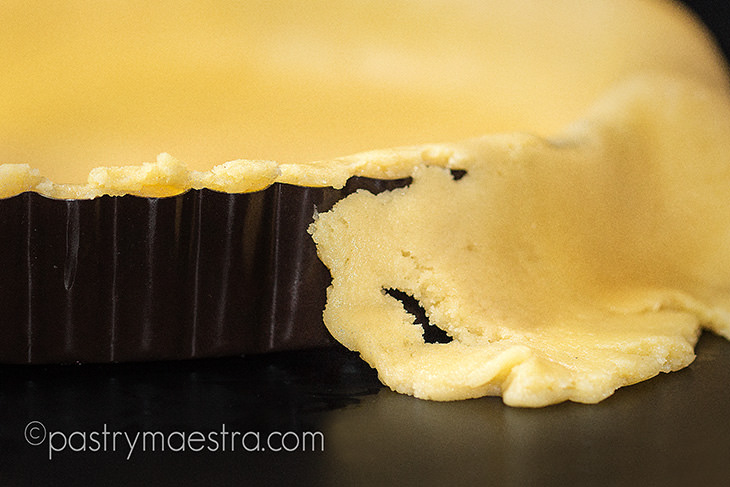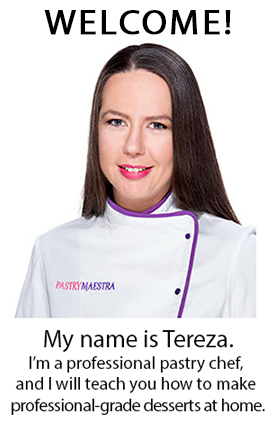![]()
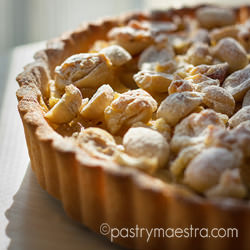
C
hocolate and caramel tart, raspberry and almond tart, apple tart, lemon meringue tart, vanilla custard and fresh fruit tart, chocolate ganache tart, Sablé cookies, Viennois cookies, Linzer cookies, quiche Lorraine … to make it short and sweet – shortcrust pastry!
What is Shortcrust Pastry?
Shortcrust pastry (Pâtes Sèches [pα:t sεʃ] – dry pastry) is composed of flour, fat (butter, lard or margarine), salt, binder (eggs, water or milk) and some sugar. It can be sweet or savory. There are several forms of this pastry, and they have different textures depending on the ratio of ingredients used. No matter what sort of recipe you use, shortcrust pastry has to be kneaded as quickly as possible and left to rest in the refrigerator before use.
Why it is Called Shortcrust Pastry?
Shortcrust pastry earned its name because it contains relatively high amount of solid fat or shortening. Fat coats the flour particles, thus preventing the development of gluten. Therefore, the fat ‘shortens’ gluten strands and makes the pastry tender and crumbly instead of chewy.
What Flour to Use?
When making shortcrust pastry, the main goal is to knead as little as you can in order to prevent gluten forming. I will remind you; gluten is a rubbery substance that develops when water comes in touch with the proteins in flour. The longer you work the dough, gluten will become more developed, your pastry will be tough and rubbery, and it will shrink when rolling and baking. So, for shortcrust pastry you shouldn’t use flour that is high in protein like, for example, bread flour. The best choice is all purpose flour. On the other hand, it is also not advisable to use gluten free flour, because your pastry will be very crumbly and hard to work with. If you want to know more on this subject, take a look at my post about flour.
What Type of Fat to Use?
The choice of shortening that will be used in making shortcrust pastry is very important. Butter will provide the best flavor, but the texture of pastry is less flaky than the one achieved by using lard. Unlike butter, lard is 100% fat, and its particles coat flour specs better thus preventing water form forming gluten. Therefore, some bakers prefer to use a mixture of butter and lard in order to achieve the optimum harmony of flavor and texture. The other options are vegetable margarine, which is usually used due to lower costs or for special needs baking, or coconut oil for baking for vegetarians, vegans or people who avoid cholesterol intake. If you want to learn more, check my post about fats.
There is no rule about quantity of fat used when making shortcrust pastry, however, the most common recipes call for 50%-80% fat content compared to the weight of flour.
What Type of Sweetener to Use?
In most recipes you will find regular granulated sugar or powdered sugar. Since granulated sugar can not melt inside shortcrust pastry, and it stays in its original form, using it in shortcrust pastry recipes will enhance the gluten development. That will cause the pastry to absorb more liquids, and it will be tougher. I you, however, use powdered sugar, it will disturb the gluten strands, and the pastry will be less elastic and it will absorb fewer liquids.
Apart from regular sugar, you could use other sweeteners like brown sugar or honey, but they will affect the taste and the texture of the pastry.
Liquids
In order to bind all the ingredients it is necessary to add a small quantity of liquid ingredients into shortcrust pastry. The most common used are eggs that could be used whole, just egg yolks or egg whites. You could also use water, milk, cream, but even some less common used liquids such as tea, fruit juice or wine.
Other Ingredients Used for Making Shortcrust Pastry
There are some other ingredients you can add to shortcrust pastry.
Nuts
You can add chopped, whole or ground nuts to shortcrust pastry. If you are using ground nuts, it is advisable to use them along with powdered sugar which will absorb the excess fat from the nuts. The weight of nuts used shouldn’t exceed the weight of the sugar in the recipe.
Cocoa Powder
The weight of cocoa powder used shouldn’t exceed 15% of the weight of flour. If you want to change regular shortcrust pastry into chocolate one, you should swap up to 15% quantity of flour for the same quantity of cocoa powder.
Leavening Agents
If you want to add baking soda to your shortcrust pastry, you should add up to 10g (4Tsp) for every 1kg (2.2lbs) of flour. You can add up to 20g (5Tsp) of baking powder for every 1kg (2.2lbs) of flour.
Two Methods of Making Shortcrust Pastry
Rub-in Method or Sablée [sable] Method
Sablée method calls for rubbing sifted flour and salt into dices of cold butter with your fingertips. This process enables coating of flour particles with fat and that prevents water from reaching flour, so gluten doesn’t develop like – for example – in yeast dough. When you get crumbly mixture without large chunks of butter, add liquid ingredients and combine them quickly. Now the food processor can be used, thus speeding up the process and making it easier. It is very important that you don’t overwork the butter because the dough will become too fragile. However, if you underwork the butter, your dough will bee too dry, dense and tough. You could also use a food processor – put the dry ingredients and cold butter cut in dices inside, and pulse until you get crumbly mixture.
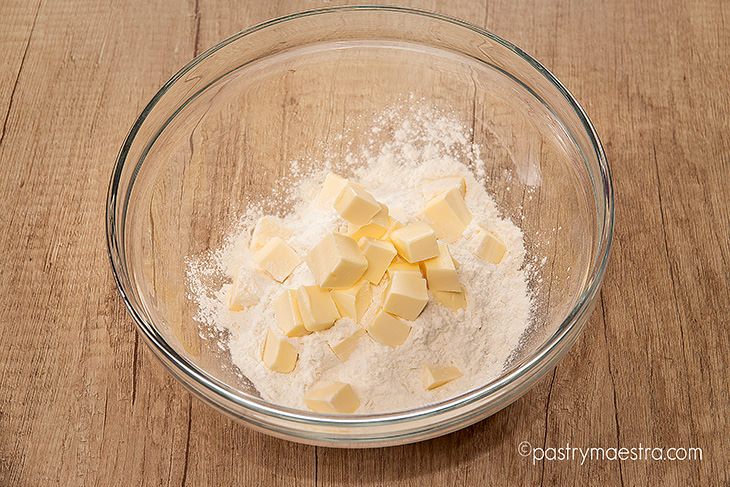
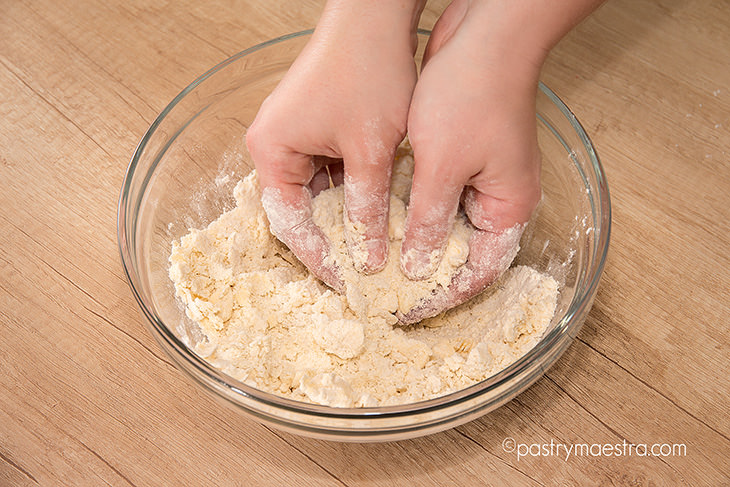
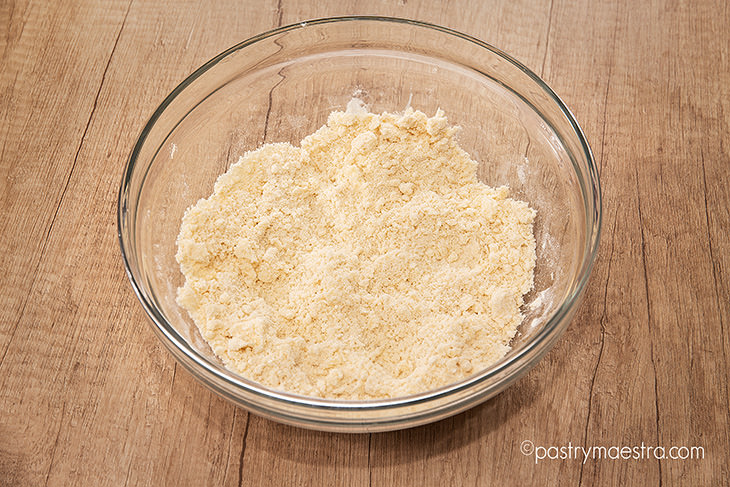
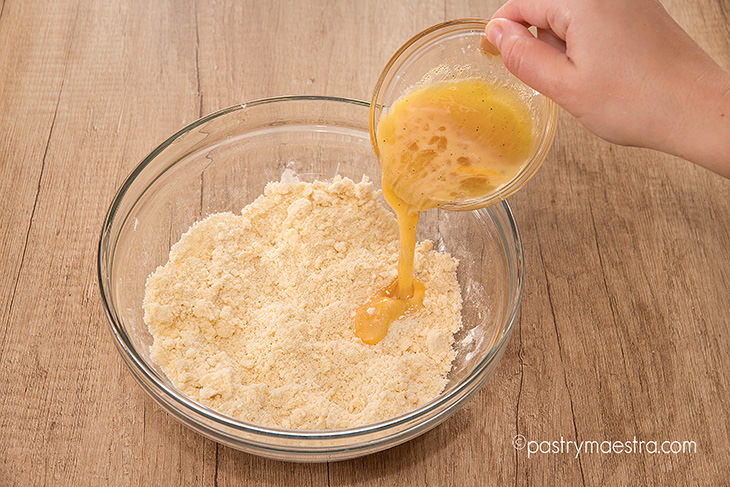
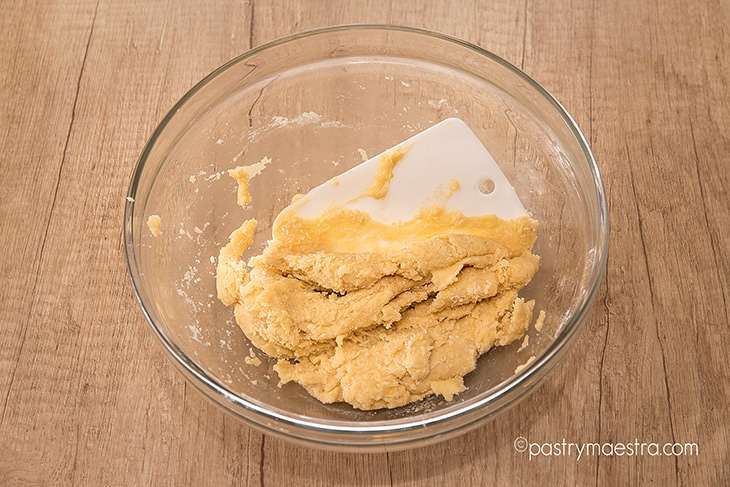
Creaming Method
Creaming method requires creaming butter with sugar in a stand mixer until light and fluffy. After that, liquid ingredients are gradually added to the mixture. Sifted dry ingredients are folded into the mixture in the end. The dough is left to rest in the refrigerator until firm.
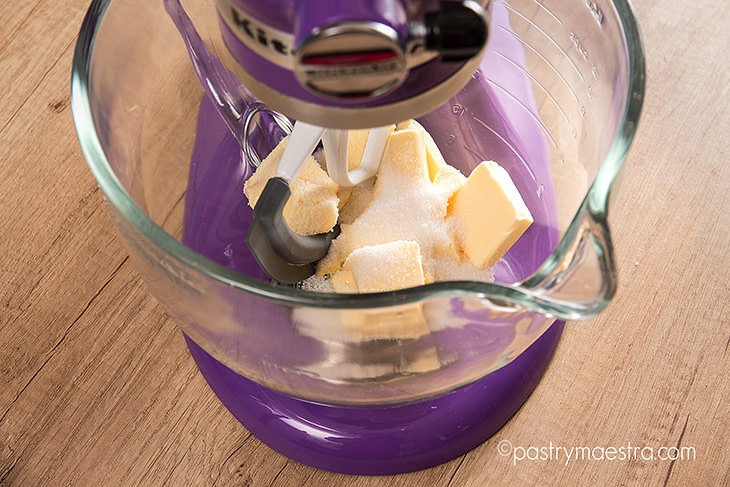

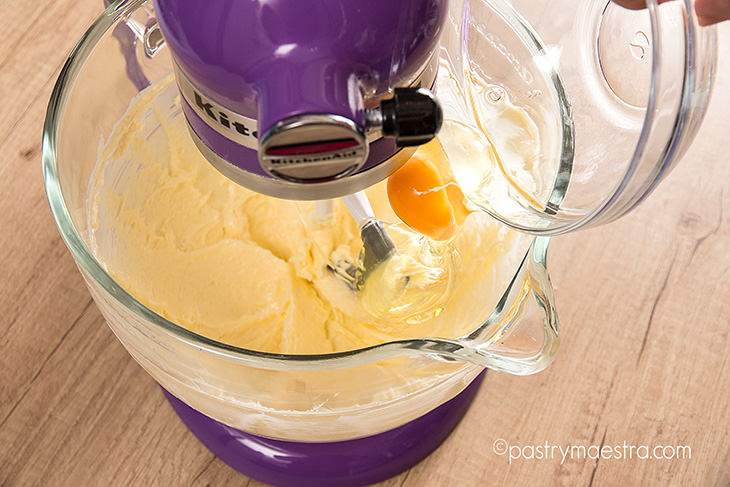

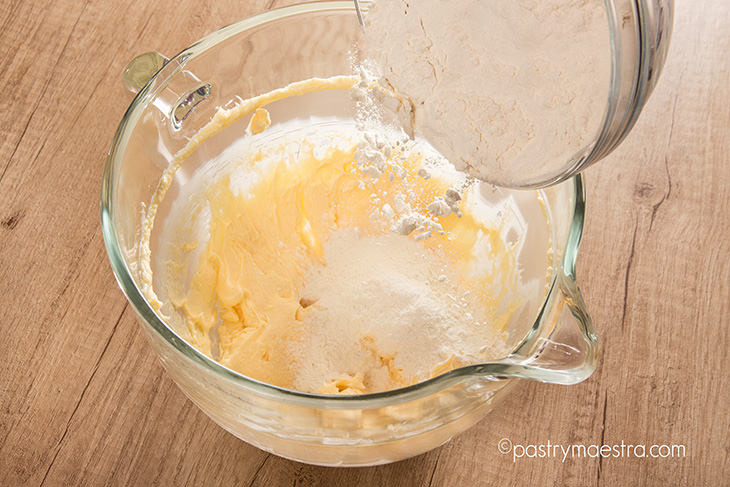
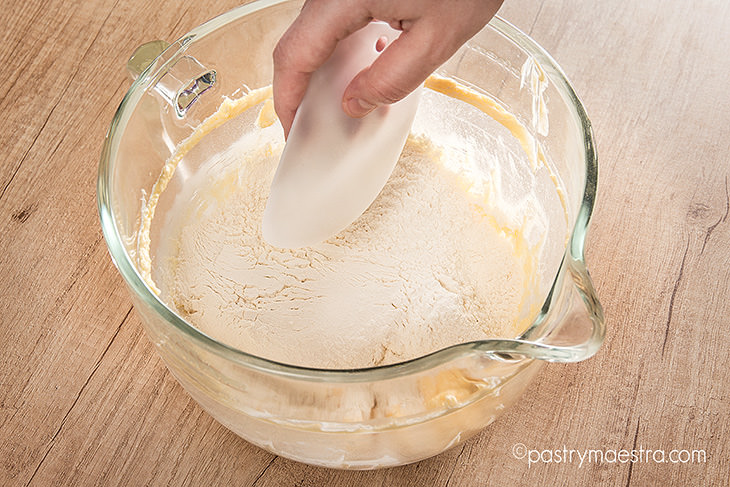
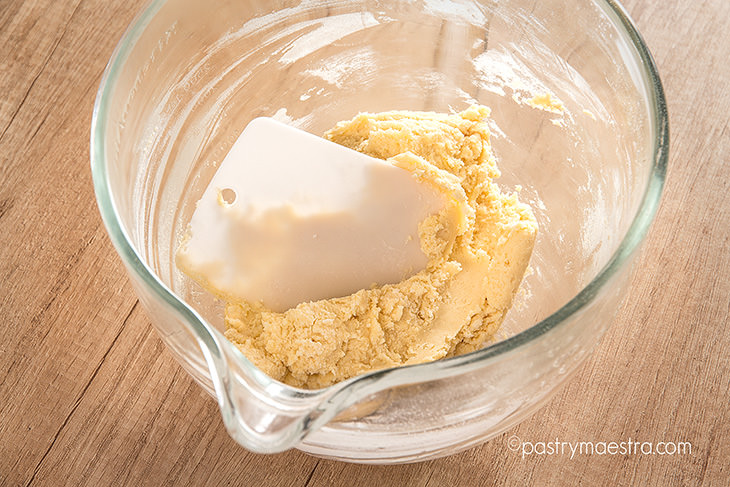
Types of Shortcrust Pastry
There are numerous recipes for shortcrust pastry with different ratios of flour, butter and sugar needed. I am giving you a couple of recipes here, and if you want to see more, check my chocolate ganache tart, soft caramel and chocolate ganache tart, raspberry and poppy seed tart, Greek yogurt and raspberry semifreddo, lemon meringue tart, viennois cookies, and many more recipes.
Pâte Brisée (broken dough) or Pâte à Foncer (Fr. enfoncer = to embed)
Pâte Brisée [pα:t brize], also known as pâte à foncer [pα:t a fɔ̃se] is flaky and crunchy, and it is often used as a base for tarts and pies. It can be sweet if we use it for tarts and pies, or savory if we are making quiches or savory tarts. Pâte Brisée usually contains water as binder, but in some cases, instead of water, it can contain whole egg or egg yolk only.
Savory Pâte Brisée Recipe
by:Tereza Alabanda,The Pastry Maestra
Prep. time : 10 minutes
Ready in 30 minutes
Level : Basic
Ingredients:
- All purpose flour 200g (7oz)
- Butter 100g (3.5oz)
- Salt 5g (1Tsp)
- Egg 50g (1.8oz or 1 medium egg) – optional
- Water as needed
Directions
- Sift flour with salt in a bowl. Cut cold butter into dices and add it to the flour. Rub the flour into the butter with your fingertips until you get crumbly mixture.
- In another bowl whisk one egg and mix in water. If you decide not to use the egg, you can replace it with water. Add the liquid ingredients to the crumbs and combine them quickly.
- Flatten the dough and wrap it in a plastic film. Leave in the refrigerator until firm and cold.
Copyright© PastryMaestra.comTM
Sweet Pâte Brisée Recipe
by:Tereza Alabanda,The Pastry Maestra
Prep. time : 10 minutes
Ready in 30 minutes
Level : Basic
Ingredients:
- All purpose flour 200g (7oz)
- Butter 100g (3.5oz)
- Salt 5g (1Tsp)
- Sugar 40g (1.4oz)
- Egg 50g (1.8oz or 1 medium egg) – optional
- Water as needed
Directions
- Sift flour with salt in a bowl. Cut cold butter into dices and add it to the flour. Rub in the flour into the butter with your fingertips until you get crumbly mixture.
- In another bowl whisk one egg, mix in water and sugar. If you decide not to use the egg, you can replace it with water. Add the liquid ingredients to the crumbs and combine them quickly.
- Flatten the dough and wrap it in plastic film. Leave it in the refrigerator until firm and cold.
Copyright© PastryMaestra.comTM
Pâte Sucrée
Pâte Sucrée [pα:t sykre] or ‘sweet pastry’ is shortcrust pastry made with the larger amount of sugar than Pâte Brisée, and it also contains eggs as a binder. Pâte Sucrée is used for making tart shells, cookies, or as a base for a layered dessert.
Pâte Sucrée Recipe
by:Tereza Alabanda,The Pastry Maestra
Prep. time : 10 minutes
Ready in 30 minutes
Level : Basic
Ingredients:
- All purpose flour 200g (7oz)
- Butter 100g (3.5oz)
- Powdered sugar 100g (3.5oz)
- Egg 50g (1.8oz or 1 medium egg)
- Salt 1g (1⁄16Tsp)
Directions
- Put softened butter with powdered sugar into bowl of a stand mixer. Mix with paddle attachment until light and creamy.
- Add one egg and mix until incorporated.
- Stop mixing and fold in sifted flour and salt using a silicone spatula, until well combined. Don’t overwork the pastry. Flatten the dough and wrap it in a plastic film. Leave it in the refrigerator until firm and cold.
Copyright© PastryMaestra.comTM
Pâte Sablée
Pâte Sablée [pα:t sable] or sandy pastry is used for making fine, delicate pastries, and petits fours. It contains even more fat than other types of shortcrust pastry, and it can also contain extra egg yolks. This is the richest of all shortcrust pastries. The high fat content makes it fragile and difficult to work with, so you should keep it well chilled before rolling.
Pâte Sablée Recipe
by:Tereza Alabanda,The Pastry Maestra
Prep. time : 10 minutes
Ready in 30 minutes
Level : Basic
Ingredients:
- All purpose flour 200g (7oz)
- Butter 110g (4oz)
- Powdered sugar 75g (5Tbsp)
- Egg 50g (1.8oz or 1 medium egg)
- Salt 1g (1⁄16Tsp)
- Milk if needed
Directions
- Put softened butter with powdered sugar into a bowl of a stand mixer. Mix with paddle attachment until light and creamy.
- Add one egg and mix until incorporated.
- Stop mixing and fold in sifted flour and salt using a silicone spatula, until well combined. Don’t overwork the dough. Flatten it and wrap in a plastic film. Leave it in the refrigerator until firm and cold.
Copyright© PastryMaestra.comTM
Well, it turns out that the short(crust) story actually became quite long – sorry – my bad! I just wanted to teach you everything you need to know about it! So, now chill your butter, sift your flour, take a look at my post about lining a tart mold, and start making one of those delightful goodies from the beginning of this post! Enjoy!
